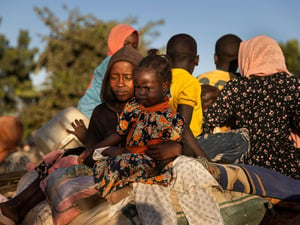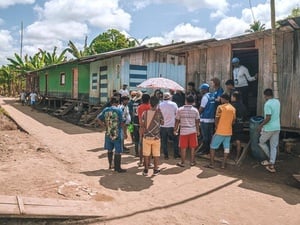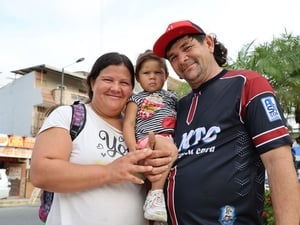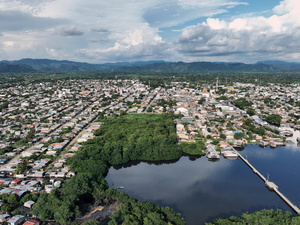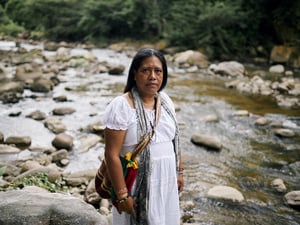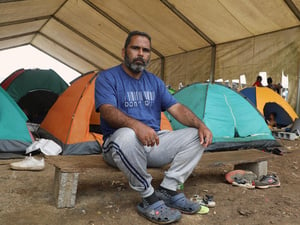Colombia: growing impact of forced displacement
Colombia: growing impact of forced displacement
UNHCR is concerned about the growing impact of forced displacement and violence on the indigenous peoples of Colombia. Attacks against indigenous communities and their leaders are reportedly on the increase this year. There are even fears that, if the present trend continues, some of the smaller and more vulnerable groups and their cultures may actually disappear as they are driven from their ancestral lands and disperse - possibly never to return.
In the past week, fighting between the Colombian Army and guerrillas from the Revolutionary Armed Forces of Colombia (FARC) caused the displacement of an estimated 3,500 indigenous Nasa people from the area around the village of Toribío, in the south-western province of Cauca. All observers on the ground agree that if fighting continues, the number of displaced Nasas could quickly reach as many as 5,000. Today (22 April), UNHCR and other United Nations agencies are visiting the area in order to evaluate the humanitarian needs of the population and support relief efforts by civilian authorities. (Note: The Nasas are one of the largest indigenous groups in Colombia, about 120,000 people.)
Meanwhile, in the north-western province of Chocó, some 4,000 indigenous Embera people are at imminent risk of displacement because of fighting between guerrillas and paramilitary groups in the Bojaya area. In March 2004, over 1,200 people from five indigenous communities in this area were forced to flee their homes. Since the beginning of this year, the irregular armed groups have increased their activities in the area, imposing blockades to stop food, medicine, fuel and other vital supplies from reaching some communities.
The National Indigenous Organization of Colombia (ONIC), a UNHCR partner, has reported the murder or disappearance of more than 20 indigenous leaders so far this year.
Colombia's more than 80 indigenous groups together make up a population of just under 1 million people. Although indigenous people represent only 2 to 3 percent of Colombia's total inhabitants, they make up as much as 8 percent of the country's internally displaced population of more than 2 million. Virtually all the indigenous groups in the country have been victims of forced displacement or are at serious risk of being displaced from their ancestral lands.
The tragedy afflicting the indigenous peoples remains largely invisible. They often become displaced within their remote regions of origin as they try to preserve ties to their ancestral lands, or else they flee into other remote areas where they cannot be easily detected.
Since indigenous identity and culture are closely linked to the land, these communities suffer irreversible damage when forced to flee. This can mean loss of traditional and cultural patterns, including language, and a dramatic deterioration of lifestyle.
In the northern region of the Sierra Nevada de Santa Marta, some 40,000 people belonging to four indigenous groups (Wiwas, Koguis, Kankuamos and Arhuacos) are struggling to survive and defend their culture. Caught between different armed groups fighting for control of this strategic area, the peoples of the Sierra Nevada face threats to their lives and to their heritage.
The Awá, who live along the border with Ecuador, have borne the brunt of the conflict in the southern province of Nariño. They have been subjected to pressures and threats, economic blockades, forced displacement and the murder of their leaders. Other peoples such as the Eperara-Siapidaara, the Pasto, the Quillacinga, the Inga and the Kofan have also been affected by the armed conflict in this part of Colombia. The Eperara-Siapidaara, along Colombia's Pacific coast, have been victims of forced recruitment by irregular armed groups and are also at risk of displacement.
We call on the Colombian authorities to take urgent measures to protect indigenous communities and leaders and to investigate all the murders and other crimes committed against them. We also call upon all the parties to the conflict to respect the principles of International Humanitarian Law, respect the rights of the civilian population and refrain from involving civilians in the conflict.
In Colombia, UNHCR works to protect the rights of indigenous peoples, to promote the participation of indigenous women in their communities decision-making processes, and to strengthen indigenous organizations in order to improve their response capacity. UNHCR's projects in indigenous communities include helping people to obtain official identification documents; training teachers to address the needs of displaced children; recreational activities for indigenous youth; human rights training; and projects to help indigenous communities document the principles of their culture.


